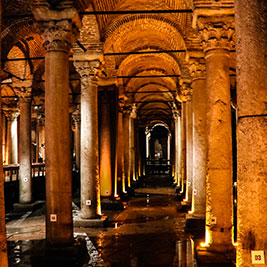The Basilica Cistern or Yerebatan Sarayı, which means sunken palace, is the largest remaining Byzantine cistern in Istanbul with a dimension of 70 m wide and 140 m long.
Historical Background
The Basilica Cistern was constructed after the Nika Revolt in 532 CE by the Byzantine Emperor Justinian the Great. The complex was known in ancient Constantinople as the Basilica Cistern since it was located under a large square, the Stoa Basilica. Throughout the Byzantine period, the cistern was used to store the 80,000 cubic meters of water-supply of the Great Palace and the other buildings on the First Hill. After the conquest by Mehmet II, the cistern continued to provide water to the Topkapı Palace and its gardens. The water was pumped through a system of nearly 20 km of aqueducts from a reservoir in the Belgrade Forest, near the Black Sea. Yerebatan Saray fell into disuse during the Ottoman period and was kept as a junkyard until it was cleaned and restored by the Istanbul Municipality in 1985-88.
The Basilica Cistern featured in the Dan Brown novel Inferno and its 2016 film adaptation.
Sights & Photos of the Basilica Cistern
The ceiling of the reservoir is supported by a forest of 336 marble columns, each 9 meters high. The majority of the columns in the cistern are shaped like a cylinder and appear to have been recycled from the ruins of older buildings. The columns are topped by mainly Ionic and Corinthian style capitals. One of the columns is carved with raised pictures of a peacock-eye, slanted branches, and tears. Since it is always wet, it is called the Crying or Tearing Column. It resembles the columns of the Triumphal Arch of Theodosius I from the 4th century (CE 379–395) at the Forum Tauri square, which was excavated in 1965 at Beyazit Meydanı. According to popular belief, the Crying Pillar was erected for the memory of the hundreds of slaves who lost their lives during the construction of the cistern.
In the northwest corner of the Basilica Cistern, there are two columns supported by the heads of Gorgons (or Medusa), great works of art from the Roman Period. One of the heads is upside down and the other on its side. These Gorgon heads and the two outside the Archaeological Museum belonged to the Forum of Constantine, but the exact structure from which the Medusa heads were taken remains unknown. According to legend, Medusa was one of the three Gorgons, female monsters in the underground world in Greek mythology. The snake-head Medusa, one of the three sisters, has the power of gorgonizing the ones that happen to look at her. Gorgone paintings and sculptures were used for protecting big structures and special venues in that time. Accordingly, putting the head of the Medusa in the cistern was for protection purposes. In another version of the myth, as it was told by Ovid in his Metamorphoses, Medusa was a girl with black eyes, long hair and a beautiful body who boasted that she was more beautiful than any. By doing this, she enraged Athena who turned Medusa's beautiful hair into serpents and made her face so terrible that whoever happened to look at it would turn into stone. Later, the Greek hero Perseus headed off Medusa and offered her head to Athena.
Here are the photos of the Basilica Cistern, click on the thumbnails to get a greater picture
https://turkeyphotoguide.com/basilica-cistern?tmpl=component&print=1&layout=default#sigProIda6e57ee720





